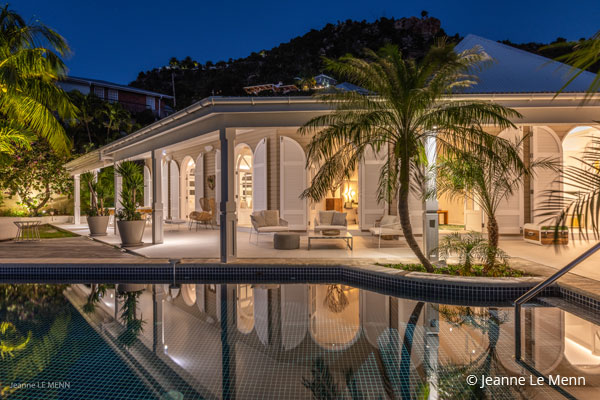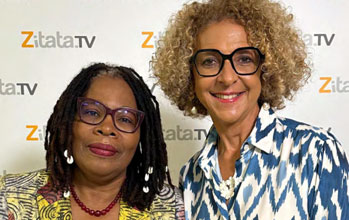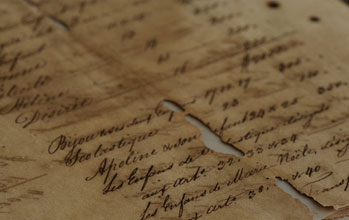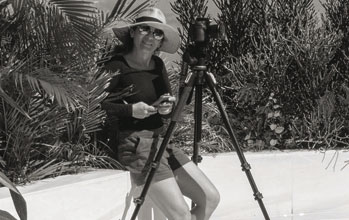
Can you tell us about your background and your relation to St-Barths ?
I grew up on the island and went to France to study marketing and business. After a master’s degree in sustainable development, it was quite natural for me to come back home in 2010.
Nothing seems quite coherent in my career when I list my diplomas and jobs for the past three years, in very eclectic areas: car rental, nautical center, sea freight, or also real estate… I already liked to take pictures when I was a teenager, but I never thought it could become a job, and I often painted on canvas and wood because I had always seen my mother painting.
How did you get into photography? And when did you get started?
When I was working for a real estate agency, I had the opportunity to combine my job as administrative and financial manager with the shooting of villas. I trained in Paris with Guillaume Mussau, while I was on vacation in France. I kept studying, practicing, seeking for improvement and creating my style. I finally decided to start my own business after a frantic rhythm of photo reports of about 2 villas per week for the agency for 2 years… in addition to my work responsibilities.
Over time, I have expanded my services and I now offer real estate photography for villas, hotels, shops, architects, decorators but also more “lifestyle” photos for professional communication such as food, tableware, ambiance or products photography… as well as portraits for my clients.
 What does photography mean to you?
What does photography mean to you?
This is quite hard to answer that…
Photography is my profession, but I also have many interests that I have put aside in recent years so I could focus on it.
Photography is very technical, very precise, very sharp. You can’t imagine all the things you have to master… At least as far as I am concerned, because I didn’t grow up with a camera in my hands nor in this field. First of all, you need to know how to use your camera, be aware of its limits and anticipate what it’s going to do in such or such situation.
Then you need to master software programs, for digital development and retouching; the maintenance of photo and computer equipment; framing, composition, during shootings. And it gets more complex when you use artificial light like flash. You never get bored when you learn on the spot without first going to photography school. And all this requires a big financial investment, both for buying equipment, always more sophisticated, and for training.
It is very subjective, like most artistic jobs, and I had to learn how to assert my ideas, be less afraid of judgment… What matters is not what it represents but what it brought me. I must admit that I often thought about giving up, since I am so intransigent and a perfectionist, to the point where I have doubts about everything. I have the qualities of my weaknesses. I also see my professional choice as an opportunity to go beyond my fears, doubts and blockages in order to transcend myself, at my level and in total humility.
 I really like the challenging aspect of my work because my clients -mainly professionals- have marketing needs: They need the image to sell: My photos must reflect their intention, state of mind, translate their DNA. It is about branding beyond a visual identity such as the logo, color code…
I really like the challenging aspect of my work because my clients -mainly professionals- have marketing needs: They need the image to sell: My photos must reflect their intention, state of mind, translate their DNA. It is about branding beyond a visual identity such as the logo, color code…
Villa owners are also professionals, their goal is to rent their property. Let’s look at the situation from another angle: you are going on vacation, and you want to rent a house, you know where. The pictures of the properties available are the first thing you look at to make a choice. Some pictures will be more attractive than others. Only then will you look at the functional features. The first step is to look at the picture…
Today I see villas with potential but mediocre images or with potential but clearly little effort put into decoration.
How would you characterize your work?
My French slogan means “creating images in your image”. My job is, most of the time, to integrate myself into the project of a client, a team, a brand during a shooting and to create the visual supports they need. I make sure that they are aware of my work and my universe because my images have a distinctive look.
We each have our own references for describing a pleasing image and they are rarely hard, dark or bland images, (although I once had a client like that, and I was quite surprised).
To a certain extent, I may change my style to suit the project, but I have twice not signed the photos because the client wanted something very different from the way I see harmony. There are several specifics, especially related to colors, that must be remembered. For example, each screen has different factory settings. If you display the same image on different media, you will not have the same colors. Color accuracy is really important. I really want to make sure that my pictures will look the same on professional or calibrated screens. So, I trained in color management, and I got with a second screen with a built-in calibration probe that ensures faithful color and brightness management. It is about mastering images from A to Z. I don’t pretend to be a professional colorist or retoucher, but I am very careful that the image I create is faithfully the same for the others on parametric equipment.
What would you like to pass on? How do you describe your universe?
Soft and warm colors, bright images. For clients who want a high-end finish, I clean up the image with Photoshop to get a flawless image. Typically, I would erase the folds of a bed, remove the reflection in the TV, erase a lamp cable, remove leaves on the floor … It is important that each image is prepared smoothly, that emerges an impression of harmony, clarity, just that the experience is pleasant at first glance. I often move furniture for the framing, so that what I experience during the shooting, what I see, can be felt when you look at the picture. I want to freeze reality the way we see it with our superb, hyper-perfected human eye and with a camera you are subject to constraints and compromises, which do not exist when you are there in person.
 What are your plans or aspirations for development?
What are your plans or aspirations for development?
I’d rather talk about desires than projects – it puts less pressure on me.
I really like what I am doing now, and I would love to work in other destinations from time to time… Being able to choose the projects I like is a great luxury…
I have personal photo and painting series that are taking shape and that I can’t hide forever. It’s so intimidating that for a long time I thought about using a pseudonym.
I started painting again last year, after 10 years of abandonment. I had a real need to touch materials, do something concrete and spend less time in front of my computer.
When I create on canvas, I let go, I have the feeling of respecting myself, it’s quite deep but it’s very accurate. And I see the result of my decisions instantly without any possible backtracking, which is not the case in photography where you can work on a photo endlessly… It’s exhilarating, until the moment when you wonder if you have ruined everything or not…
I don’t force myself to create, there are times when I have nothing to express and other times when I go to the studio every day and produce almost non-stop. That’s where I spend all my free time.
I mainly paint on large formats and use material, that I make on the spot with my mixer and my scale to get these textures and certain renderings with drying. It is the fruit of research, of chance but especially of letting go on the result. When I get too serious about it, I remember that I am here to experiment and do it with no pressure. Depending on the series, after several days of drying, I go back to work, I add color, sand, add material, it often happens that I have 4 canvases in progress with a rotation of drying, creation in order to be able to create without interruption while the flow is there.
At the same time, I have photo series in progress, which I take the time to mature. I love my photo production work for clients, but I also need to express myself in my own way. What is considered a bad setup is an opportunity for me to create. That’s how the Capture Light series was born with Debussy’s Claire de Lune constantly in mind. The result is abstract works similar to paintings on canvas. These photos are available in art prints in limited series of 15 copies on Baryte paper in a format of about 100cm by 61 cm and a limited number of 5 copies on Plexiglas…



